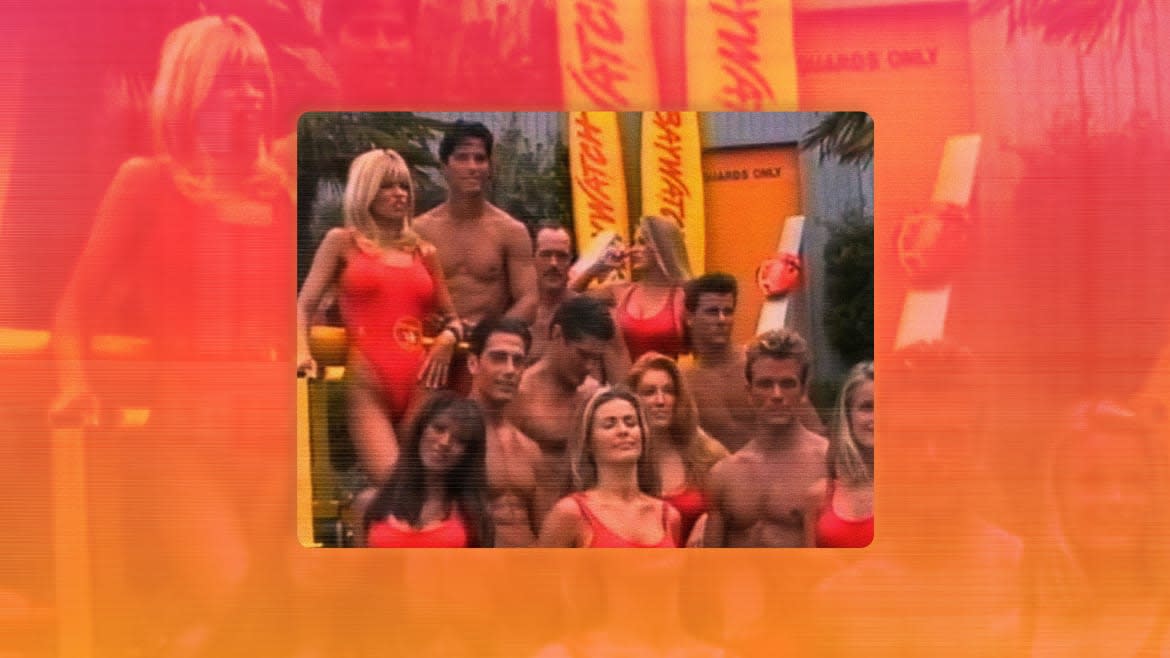The Secrets of ‘Baywatch’ Revealed in Splashy New Docuseries

Even if you’ve never seen a second of Baywatch, you’ve likely seen the indelible image of gorgeous women and hunky men running along the beach in red bathing suits. The show, starring David Hasselhoff and Pamela Anderson, dominated airwaves in the 1990s, running from 1989 to 2001, including the spinoff Baywatch: Hawaii. Nearly 25 years after the series’ conclusion, the new Hulu documentary After Baywatch: Moment in the Sun aims to explore the massive impact the show had on society as it capitalized on the idea that sex sells.
After Baywatch however, is discombobulated, too frequently getting close to interesting ideas and thoughts before rapidly cutting to something easier to digest. It ends up feeling like a promotional tool for Baywatch rather than an in-depth analysis of the famous series.
For a show that’s best remembered for slow-motion running, the documentary about it moves at breakneck speed. The editing is manic, juggling countless talking heads of actors, producers, casting directors, and consultants with Baywatch footage and stock footage of people hanging out at the beach. The quick cutting often has the feeling of a Michael Bay movie, which works if there’s mass chaos and explosions, but it feels wildly out of place in a documentary that attempts to assess the legacy of one of the most popular shows of the '90s.
It’s also confusing; you hear from dozens of people who’ve been on the show, but there’s no sense of how brief or extended their time on the series was. You can count on one hand how many times an impactful statement is actually given time to breathe and settle in so you can feel the weight of it. Typically, someone says something that’s worthy of further reflection or discussion, but After Baywatch is too busy racing to another topic.

A still from After Baywatch: Moment in the Sun.
This is most evident at the end of Episode 2, which asks if the show was racist. It quickly mentions that the NAACP took issue with the show—the only African American character was Sgt. Ellerbee, played by Gregory Allen Williams. After Baywatch then jumps to the fact that Traci Bingham joined the cast and became the first principal African American lifeguard, before abruptly ending the episode on an upbeat note, as if to suggest her casting solved the show’s problems. It also conspicuously leaves out the fact that Bingham joined in Season 7, and was only in two seasons of the 11-season show.
‘Between the Temples’: Jason Schwartzman and Carol Kane’s Unlikely Love Story
The series then picks up the topic of race again at the end of Episode 3, speaking to Williams about his experience on the show. It’s perhaps the single most moving part of the series. Williams speaks honestly about what for him was a painful experience. “Baywatch was a show that celebrated European beauty. At that point, I put up a wall between myself and the show,” he reveals.
Williams opens up a remarkable opportunity for the documentary to look inward at the topic of race and representation, but right on cue, the episode ends. It feels like someone put the various segments and shuffled them throughout the series, leaving important conversations like this one inexplicably spread out at random times in multiple episodes. It doesn’t just feel haphazard in its execution—it does a disservice to these important stories.

A still from After Baywatch: Moment in the Sun.
It gets stranger. Most of Episode 2 focuses on the undeniable impact the iconic Pamela Anderson had on the show. We see how Anderson was discovered, how she revitalized Baywatch, and her rise to becoming one of the most famous people on Earth. What’s missing is much insight from Anderson. It’s not that Anderson refused to participate in After Baywatch—she is present. But she gets just a few anecdotes throughout the show’s four episodes.
Pamela Anderson’s Redemption: We Should Be Ashamed of How She Was Treated
Why are we spending so much time listening to people talking about Anderson and speculating on what she was feeling about, say, her leaked sex tape with Tommy Lee when she herself could tell us what that experience was like? (She eventually does, but not keeping the focus on Anderson herself is bizarre and off-putting). It feels like there are more archival clips of Lee interviews than conversations with Anderson herself.
Despite the too-infrequent flash of insightful commentary, After Baywatch can’t rise above its glossy presentation, offering a slim and cursory look at Baywatch and its societal impact. It’s more of a celebration of the show than anything else. This one’s just for the most die-hard Baywatch fans.
Get the Daily Beast's biggest scoops and scandals delivered right to your inbox. Sign up now.
Stay informed and gain unlimited access to the Daily Beast's unmatched reporting. Subscribe now.
